CAWS administration increases the expression of interferon γ and complement factors that lead to severe vasculitis in DBA/2 mice
- PMID: 24063402
- PMCID: PMC3876726
- DOI: 10.1186/1471-2172-14-44
CAWS administration increases the expression of interferon γ and complement factors that lead to severe vasculitis in DBA/2 mice
Abstract
Background: Candida albicans water-soluble fraction (CAWS), a mannoprotein-β-glucan complex obtained from the culture supernatant of C. albicans NBRC1385, causes CAWS-mediated vasculitis (CAWS-vasculitis) in B6 and DBA/2 mice with mild and lethal symptoms, respectively. Why CAWS is lethal only in DBA/2 mice remains unknown.
Results: We performed DNA microarray analyses using mRNA obtained from peripheral blood mononuclear cells (PBMCs) of B6 and DBA/2 mice and compared their respective transcriptomes. We found that the mRNA levels of interferon-γ (Ifng) and several genes that regulate the complement system, such as C3, C4, Cfb, Cfh, and Fcna, were increased dramatically only in DBA/2 mice at 4 and 8 weeks after CAWS administration. The dramatic increase was confirmed by quantitative real-time polymerase chain reactions (qRT-PCR). Moreover, mRNA levels of immune-related genes, such as Irf1, Irf7, Irf9, Cebpb, Ccl4, Itgam, Icam1, and IL-12rb1, whose expression levels are known to be increased by Ifng, were also increased, but only in DBA/2 mice. By contrast, the mRNA level of Dectin-2, the critical receptor for the α-mannans of CAWS, was increased slightly and similarly in both B6 and DBA/2 mice after CAWS administration.
Conclusions: Taken together, our results suggest that CAWS administration induces Dectin-2 mediated CAWS-vasculitis in both B6 and DBA/2 mice and the expression of Ifng, but only in DBA/2 mice, which led to increased expression of C3, C4, Cfb, Cfh, and Fcna and an associated increase in lethality in these mice. This model may contribute to our understanding of the pathogenesis of severe human vasculitis.
Figures
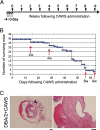
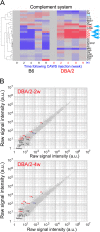
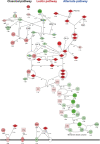
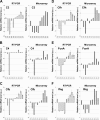
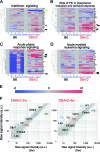
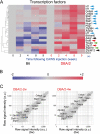
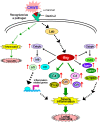
Similar articles
-
Murine model of Kawasaki disease induced by mannoprotein-beta-glucan complex, CAWS, obtained from Candida albicans.Jpn J Infect Dis. 2004 Oct;57(5):S9-10. Jpn J Infect Dis. 2004. PMID: 15507772
-
IL-10 is a negative regulatory factor of CAWS-vasculitis in CBA/J mice as assessed by comparison with Bruton's tyrosine kinase-deficient CBA/N mice.J Immunol. 2009 Sep 1;183(5):3417-24. doi: 10.4049/jimmunol.0802484. Epub 2009 Aug 12. J Immunol. 2009. PMID: 19675170
-
Beta-mannosyl linkages negatively regulate anaphylaxis and vasculitis in mice, induced by CAWS, fungal PAMPS composed of mannoprotein-beta-glucan complex secreted by Candida albicans.Biol Pharm Bull. 2006 Sep;29(9):1854-61. doi: 10.1248/bpb.29.1854. Biol Pharm Bull. 2006. PMID: 16946498
-
Chemistry and biology of angiitis inducer, Candida albicans water-soluble mannoprotein-beta-glucan complex (CAWS).Microbiol Immunol. 2003;47(7):479-90. doi: 10.1111/j.1348-0421.2003.tb03409.x. Microbiol Immunol. 2003. PMID: 12953841 Review.
-
[Coronary arteritis induced by CAWS (Candida albicans water-soluble fraction) in various strains of mice].Nihon Ishinkin Gakkai Zasshi. 2008;49(4):287-92. doi: 10.3314/jjmm.49.287. Nihon Ishinkin Gakkai Zasshi. 2008. PMID: 19001755 Review. Japanese.
Cited by
-
MIrExpress: A Database for Gene Coexpression Correlation in Immune Cells Based on Mutual Information and Pearson Correlation.J Immunol Res. 2015;2015:140819. doi: 10.1155/2015/140819. Epub 2015 Dec 3. J Immunol Res. 2015. PMID: 26881263 Free PMC article.
-
Saccharomyces cerevisiae mannan induces sheep beta-defensin-1 expression via Dectin-2-Syk-p38 pathways in ovine ruminal epithelial cells.Vet Res. 2019 Feb 4;50(1):8. doi: 10.1186/s13567-019-0624-4. Vet Res. 2019. PMID: 30717800 Free PMC article.
-
Ficolin-1 is a promising therapeutic target for autoimmune diseases.Int Immunol. 2019 Feb 6;31(1):23-32. doi: 10.1093/intimm/dxy056. Int Immunol. 2019. PMID: 30169661 Free PMC article.
-
Fungal-derived cues promote ocular autoimmunity through a Dectin-2/Card9-mediated mechanism.Clin Exp Immunol. 2017 Dec;190(3):293-303. doi: 10.1111/cei.13021. Epub 2017 Aug 30. Clin Exp Immunol. 2017. PMID: 28763100 Free PMC article.
-
FCN1 (M-ficolin), which directly associates with immunoglobulin G1, is a molecular target of intravenous immunoglobulin therapy for Kawasaki disease.Sci Rep. 2017 Sep 12;7(1):11334. doi: 10.1038/s41598-017-11108-0. Sci Rep. 2017. PMID: 28900133 Free PMC article.
References
-
- Talarico R, Baldini C, Della Rossa A, Stagnaro C, Ferrari C, Luciano N, Bombardieri S. Large- and small-vessel vasculitis: a critical digest of the 2010–2011 literature. Clin Exp Rheumatol. 2000;30(70):S130–S138. - PubMed
-
- Ohno N. Chemistry and biology of angiitis inducer, Candida albicans water-soluble mannoprotein-β-glucan complex (CAWS) Microbiol Immunol. 2003;47(7):479–490. - PubMed
-
- Shinohara H, Nagi-Miura N, Ishibashi K, Adachi Y, Ishida-Okawara A, Oharaseki T, Takahashi K, Naoe S, Suzuki K, Ohno N. Beta-mannosyl linkages negatively regulate anaphylaxis and vasculitis in mice, induced by CAWS, fungal PAMPS composed of mannoprotein-beta-glucan complex secreted by Candida albicans. Biol Pharm Bull. 2006;29(9):1854–1861. doi: 10.1248/bpb.29.1854. - DOI - PubMed
-
- Nagi-Miura N, Shingo Y, Kurihara K, Adachi Y, Suzuki K, Ohno N. Involvement of platelet activating factor, histamine and serotonin in acute lethal shock induced by Candida albicans water-soluble extracellular polysaccharide fraction (CAWS) in mice. Biol Pharm Bull. 2007;30(7):1354–1357. doi: 10.1248/bpb.30.1354. - DOI - PubMed
Publication types
MeSH terms
Substances
Associated data
- Actions
LinkOut - more resources
Full Text Sources
Other Literature Sources
Medical
Molecular Biology Databases
Research Materials
Miscellaneous

